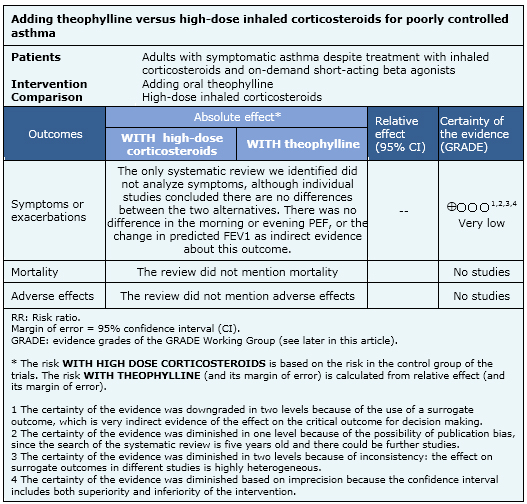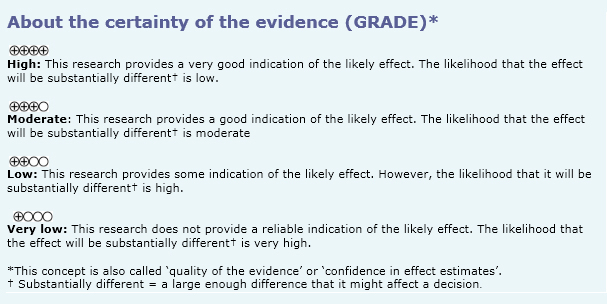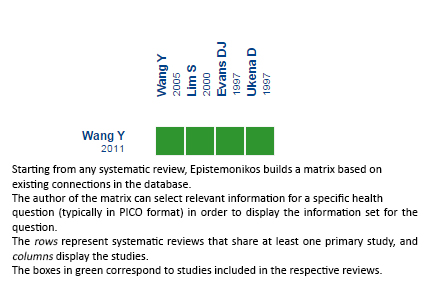 Para Descargar PDF debe Abrir sesión.
Para Descargar PDF debe Abrir sesión.
There are several management strategies for patients with poorly controlled asthma despite usual treatment. Increasing doses of inhaled corticosteroids or adding theophylline are among the therapeutic alternatives. However, the latter is associated with important adverse effects. Searching in Epistemonikos database, which is maintained by screening 30 databases, we identified only one systematic review including four pertinent randomized controlled trials. We combined the evidence using meta-analysis and generated a summary of findings following the GRADE approach. We concluded it is not clear whether theophylline or high-dose inhaled corticosteroids constitute a better alternative for symptomatic control or reduction in exacerbations in poorly controlled asthmatic patients because the certainty of the evidence is very low.
There are several management strategies for patients with poorly controlled asthma. Within the therapeutic alternatives are xanthines such as theophylline, or high-dose inhaled corticosteroids. Theophylline exerts its action on the bronchial smooth muscle relaxation, and through its anti-inflammatory and vasodilatory activity. Since theophylline is associated with important adverse effects, it is necessary to assess its potential benefits in symptomatic patients with initial therapy.
We used Epistemonikos database, which is maintained by screening more than 30 databases, to identify systematic reviews and their included primary studies. With this information we generated a structured summary using a pre-established format, which includes key messages, a summary of the body of evidence (presented as an evidence matrix in Epistemonikos), meta-analysis of the total of studies, a summary of findings table following the GRADE approach and a table of other considerations for decision-making.
|
Key messages
|
|
What is the evidence. |
We found one systematic review [1] including four randomised controlled trials [2],[3],[4],[5]. |
|
What types of patients were included |
All of the studies included patients older than 18 years who had symptomatic asthma. Two studies included patients with forced expiratory volume in 1 second (FEV1)> 50% [2],[4], one study with peak expiratory flow (PEF)> 50%, [3] and one study did not limit for lung function. Two of the studies specified there was no use of oral corticosteroids in the three weeks prior to intervention [2],[5]. The baseline therapy in all the studies was low-dose inhaled corticosteroids and short-acting inhaled beta agonists. |
|
What types of interventions were included |
All of the studies consisted of one arm receiving low-dose inhaled corticosteroids associated with theophylline and another arm receiving double dose of corticosteroids without theophylline. The dose of theophylline varied between 200 and 375 mg twice daily (depending on body weight). Two studies reported median plasma levels of theophylline (8.7 to 10.1) [2],[4]. High-dose of inhaled corticosteroids corresponded to twice the standard dose in all studies. In three studies the corticosteroid was beclomethasone (400-500 ug/day) [3],[4],[5] and in one study budesonide 400 ug/day [2]. |
|
What types of outcomes |
The systematic review meta-analyzed the following outcomes: change in morning PEF, change in evening PEF and predicted FEV1. Although symptomatic scores were reported in all studies, these results were not considered in the systematic review. Neither mortality, exacerbations nor hospitalizations were reported. |
The information on the effects of adding oral theophylline compared to the use of high-dose inhaled corticosteroids is based on four randomised controlled trials including 318 patients. All studies measured symptoms, and change in morning and evening PEF as outcomes. Three studies measured change in predicted FEV1 [1],[2],[4]. No study measured exacerbations, hospitalizations or mortality.


|
To whom this evidence does and does not apply |
|
| About the outcomes included in this summary |
|
| Balance between benefits and risks, and certainty of the evidence |
|
| Resource considerations |
|
| Feasibility |
|
|
Differences between this summary and other sources |
|
| Could this evidence change in the future? |
|
Using automated and collaborative means, we compiled all the relevant evidence for the question of interest and we present it as a matrix of evidence.
Matrix of evidence (static version).
Follow the link to access the interactive version: Increasing dose of inhaled corticosteroids or adding theophylline for unresponsive asthma
The upper portion of the matrix of evidence will display a warning of “new evidence” if new systematic reviews are published after the publication of this summary. Even though the project considers the periodical update of these summaries, users are invited to comment in Medwave or to contact the authors through email if they find new evidence and the summary should be updated earlier. After creating an account in Epistemonikos, users will be able to save the matrixes and to receive automated notifications any time new evidence potentially relevant for the question appears.
The details about the methods used to produce these summaries are described here http://dx.doi.org/10.5867/medwave.2014.06.5997.
Epistemonikos foundation is a non-for-profit organization aiming to bring information closer to health decision-makers with technology. Its main development is Epistemonikos database (www.epistemonikos.org).
These summaries follow a rigorous process of internal peer review.
Conflicts of interest
The authors do not have relevant interests to declare.

 Matrix of evidence (static version).
Matrix of evidence (static version).
 Esta obra de Medwave está bajo una licencia Creative Commons Atribución-NoComercial 3.0 Unported. Esta licencia permite el uso, distribución y reproducción del artículo en cualquier medio, siempre y cuando se otorgue el crédito correspondiente al autor del artículo y al medio en que se publica, en este caso, Medwave.
Esta obra de Medwave está bajo una licencia Creative Commons Atribución-NoComercial 3.0 Unported. Esta licencia permite el uso, distribución y reproducción del artículo en cualquier medio, siempre y cuando se otorgue el crédito correspondiente al autor del artículo y al medio en que se publica, en este caso, Medwave.

There are several management strategies for patients with poorly controlled asthma despite usual treatment. Increasing doses of inhaled corticosteroids or adding theophylline are among the therapeutic alternatives. However, the latter is associated with important adverse effects. Searching in Epistemonikos database, which is maintained by screening 30 databases, we identified only one systematic review including four pertinent randomized controlled trials. We combined the evidence using meta-analysis and generated a summary of findings following the GRADE approach. We concluded it is not clear whether theophylline or high-dose inhaled corticosteroids constitute a better alternative for symptomatic control or reduction in exacerbations in poorly controlled asthmatic patients because the certainty of the evidence is very low.
 Autores:
Pilar Celis[1,2], Gabriel Rada[1,2,3,4,5]
Autores:
Pilar Celis[1,2], Gabriel Rada[1,2,3,4,5]

Citación: Celis P, Rada G. High-dose inhaled corticosteroids or addition of theophylline in patients with poorly controlled asthma?. Medwave2015;15(Suppl 2):e6224 doi: 10.5867/medwave.2015.6224
Fecha de publicación: 19/8/2015

Nos complace que usted tenga interés en comentar uno de nuestros artículos. Su comentario será publicado inmediatamente. No obstante, Medwave se reserva el derecho a eliminarlo posteriormente si la dirección editorial considera que su comentario es: ofensivo en algún sentido, irrelevante, trivial, contiene errores de lenguaje, contiene arengas políticas, obedece a fines comerciales, contiene datos de alguna persona en particular, o sugiere cambios en el manejo de pacientes que no hayan sido publicados previamente en alguna revista con revisión por pares.
Aún no hay comentarios en este artículo.
Para comentar debe iniciar sesión
 Medwave publica las vistas HTML y descargas PDF por artículo, junto con otras métricas de redes sociales.
Medwave publica las vistas HTML y descargas PDF por artículo, junto con otras métricas de redes sociales.
 Wang Y, Lin K, Wang C, Liao X. Addition of theophylline or increasing the dose of inhaled corticosteroid in symptomatic asthma: a meta-analysis of randomized controlled trials. Yonsei Med J. 2011 Mar;52(2):268-75. | CrossRef | PubMed |
Wang Y, Lin K, Wang C, Liao X. Addition of theophylline or increasing the dose of inhaled corticosteroid in symptomatic asthma: a meta-analysis of randomized controlled trials. Yonsei Med J. 2011 Mar;52(2):268-75. | CrossRef | PubMed | Evans DJ, Taylor DA, Zetterstrom O, Chung KF, O'Connor BJ, Barnes PJ. A comparison of low-dose inhaled budesonide plus theophylline and high-dose inhaled budesonide for moderate asthma. N Engl J Med. 1997 Nov 13;337(20):1412-8. | PubMed |
Evans DJ, Taylor DA, Zetterstrom O, Chung KF, O'Connor BJ, Barnes PJ. A comparison of low-dose inhaled budesonide plus theophylline and high-dose inhaled budesonide for moderate asthma. N Engl J Med. 1997 Nov 13;337(20):1412-8. | PubMed | Lim S, Jatakanon A, Gordon D, Macdonald C, Chung KF, Barnes PJ. Comparison of high dose inhaled steroids, low dose inhaled steroids plus low dose theophylline, and low dose inhaled steroids alone in chronic asthma in general practice. Thorax. 2000 Oct;55(10):837-41. | PubMed |
Lim S, Jatakanon A, Gordon D, Macdonald C, Chung KF, Barnes PJ. Comparison of high dose inhaled steroids, low dose inhaled steroids plus low dose theophylline, and low dose inhaled steroids alone in chronic asthma in general practice. Thorax. 2000 Oct;55(10):837-41. | PubMed | Ukena D, Harnest U, Sakalauskas R, Magyar P, Vetter N, Steffen H, Leichtl S, Rathgeb F, Keller A, Steinijans VW. Comparison of addition of theophylline to inhaled steroid with doubling of the dose of inhaled steroid in asthma. Eur Respir J. 1997 Dec;10(12):2754-60. | PubMed |
Ukena D, Harnest U, Sakalauskas R, Magyar P, Vetter N, Steffen H, Leichtl S, Rathgeb F, Keller A, Steinijans VW. Comparison of addition of theophylline to inhaled steroid with doubling of the dose of inhaled steroid in asthma. Eur Respir J. 1997 Dec;10(12):2754-60. | PubMed | Wang Y, Wang CZ, Lin KX, Qian GS, Zhuo WL, Li SP, et al. Comparison of inhaled corticosteroid combined with theophylline and double-dose inhaled corticosteroid in moderate to severe asthma. Respirology. 2005 Mar;10(2):189-95. | PubMed |
Wang Y, Wang CZ, Lin KX, Qian GS, Zhuo WL, Li SP, et al. Comparison of inhaled corticosteroid combined with theophylline and double-dose inhaled corticosteroid in moderate to severe asthma. Respirology. 2005 Mar;10(2):189-95. | PubMed | Executive Committee GEMA 2009. GEMA 2009 (Spanish guideline on the management of asthma). J Investig Allergol Clin Immunol. 2010;20 Suppl 1:1-59. | PubMed |
Executive Committee GEMA 2009. GEMA 2009 (Spanish guideline on the management of asthma). J Investig Allergol Clin Immunol. 2010;20 Suppl 1:1-59. | PubMed |